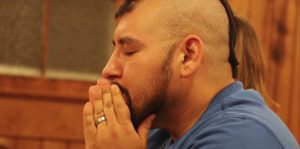
While recent years have given us a big wave of transgender public figures and iconic trans characters in film, we’re still a long way from adequate trans representation in American culture. With the rising rate of hate crimes against trans people and the Trump administration’s transphobic policies, there is a need for more media that spreads awareness of what trans people have to go through. Helping to close the gap is America In Transition, a series of docu-shorts that focus on the lives of trans people of color living in the USA.
As a white, straight, cisgender man, I can’t say what America In Transition looks like from the perspectives of its subjects’ communities, but it struck a good balance of education and empathy for me. Especially since I’ve lived in South Korea for the past two years, where gender norms are strict, and I’m not around any out trans people in my day-to-day life, it was a reality check to not just read about, but actually, witness the perils of being transgender in America. Each of the four episodes aims to highlight the personal lives of its subjects, the social realities they face, and how the two intertwine.
“…series of docu-shorts that focus on the lives of trans people of color living in the USA.”
The first episode focuses on Nina and Greta, the owners and operators of Trans Lifeline, the first suicide hotline specifically designed by trans people for trans people. The episode has three components; the first takes a bird’s eye view of the statistics and reasons behind trans people’s struggles with mental health, and since they are experts on the subject, the interviews with Nina and Greta are highly informative. Nina is also an Indian woman whose immigration status is at risk, and the second part of the episode shows what happened when the couple was stopped at a random border checkpoint in Arizona. Nina was imprisoned in Eloy, an immigration detention center, and the appalling conditions of her arrest and imprisonment are brutally outlined. Finally, there is a long section about Sisterwood, a DIY living space that Nina and Greta open on a plot of land in the middle of the Mojave Desert. As we see them build a model of independent living and reflect on what we’ve just seen, it becomes clear that however much joy goes into Sisterwood, it’s unacceptable that it’s necessary for these people to build themselves escape from mainstream America.
The second episode is far weaker than the first. It focuses on Dezjorn Gauthier, a trans male model who is working to raise the fashion-world profiles of the communities he belongs to the trans community and the African-American community. He seems like an interesting guy, but the problems with this episode come down to stagey, poorly presented interviews. For example, in a scene where Dezjorn and his fiancé walk through the park and talk about their future, the conversation feels scripted or otherwise forced—it’s like, who asks their fiancé, “What’s the most important part of parenting to you?” on camera, as if that was the first time they’d talked about that? Most scenes give you that feeling. There’s also a sequence where we see a photo of Dezjorn pre-transition and another person uses his deadname (his name from before he transitioned). Maybe Dezjorn is comfortable hearing his deadname, at least from certain people, but my impression is that for the majority of trans people, hearing their deadname is really unpleasant. It’s an odd and potentially dangerous choice for the episode to show that without explaining the issue.
“…a heartfelt exploration of trans life…a valuable learning tool for cis communities.”
The third episode gets the show back on its feet with a profile of Tiommi Luckett, an advocate for trans people with HIV. This episode focuses less on Tiommi’s professional achievements and more on a well-rounded portrait of her as an ambitious and confident person who happens to have HIV. Despite the advancements made in HIV prevention and treatment, people with the virus are still stigmatized, so I think the episode makes a good call in focusing on Tiommi’s relatability and joyful personality. At the same time, her interviews cover some very emotionally raw ground; one part has a detailed description of a sexual assault, so viewers should only watch if they’re ready for that. I was a bit shaken after watching it, but as difficult as this episode is, it’s worth your time.
Episode four looks at Z, a military veteran who was discharged under Don’t Ask, Don’t Tell for being a “lesbian.” Now living life as a trans man, he is an activist who fights against the invasive policies of North Carolina’s HB2 bill. While HB2 is most famous for its ridiculous patrolling of trans people’s bathroom use, Z explains that its problems are further reaching than that. But this episode focuses less on HB2 and more on Z’s personal life. As we see him practice archery with his family and go to church, it becomes clear that there are trans people from all cultures and communities within America, even ones that are typically contrasted with trans people in the media.
Although it’s not perfect, America In Transition is a heartfelt exploration of trans life and could serve as a valuable learning tool for cis communities. When it’s firing on all cylinders, it does what the best social-issue documentaries do. It’s sensitively directed to illuminate the broadest possible range of trans experiences, while also profiling its subjects’ lives with depth and warmth.
"…"...an odd and potentially dangerous choice for the episode...""

